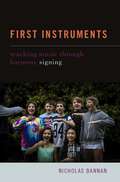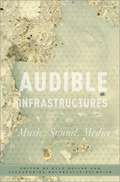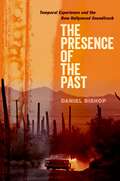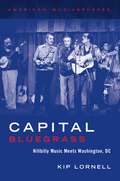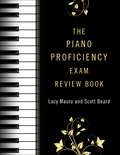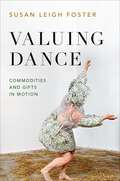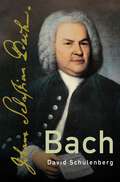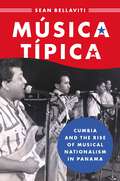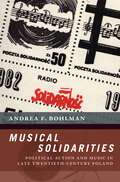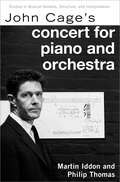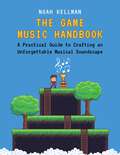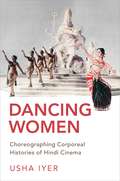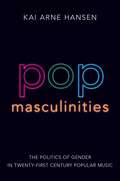- Table View
- List View
First Instruments: Teaching Music Through Harmony Signing
by Nicholas BannanWritten for music educators from K - 5 onwards, First Instruments is a practical guide to teaching musical ideas through the first instruments we develop in early childhood, laying the foundation for how the collective creativity the book presents can sustain a lifelong commitment to music-making: voice and hand gestures. Founded on the belief that all children are musical, the book gives music teachers the necessary tools to develop students' confident understanding of pitch relationships through improvisation and composition. Author Nicholas Bannan, a veteran pedagogue and children's choir director, accomplishes this in a classroom-tested system that combines Kodály hand signs with extended use of physical motions that together result in deeply embodied musical knowledge. By participating in the book's many group exercises, students develop this knowledge that ultimately paves the way for acquisition and functional working knowledge of harmony that tends to elude most theory students. As Bannan shows, all effective music teaching needs to involve singing as the portal to a secure and transferable response to pitch. First Instruments encourages educators to draw on games, tasks, and activities in relation to their own curriculum planning. Marrying the development of fluent singing abilities with harmonic understandings, this approach supports musical creativity that is not dominated by the conventional features of a particular genre or style, but instead liberates the musical imagination and enables the exploration of musical styles from throughout history and all over the world.
FIRST INSTRUMENTS C: Teaching Music Through Harmony Signing
by Nicholas BannanWritten for music educators from K - 5 onwards, First Instruments is a practical guide to teaching musical ideas through the first instruments we develop in early childhood, laying the foundation for how the collective creativity the book presents can sustain a lifelong commitment to music-making: voice and hand gestures. Founded on the belief that all children are musical, the book gives music teachers the necessary tools to develop students' confident understanding of pitch relationships through improvisation and composition. Author Nicholas Bannan, a veteran pedagogue and children's choir director, accomplishes this in a classroom-tested system that combines Kodály hand signs with extended use of physical motions that together result in deeply embodied musical knowledge. By participating in the book's many group exercises, students develop this knowledge that ultimately paves the way for acquisition and functional working knowledge of harmony that tends to elude most theory students. As Bannan shows, all effective music teaching needs to involve singing as the portal to a secure and transferable response to pitch. First Instruments encourages educators to draw on games, tasks, and activities in relation to their own curriculum planning. Marrying the development of fluent singing abilities with harmonic understandings, this approach supports musical creativity that is not dominated by the conventional features of a particular genre or style, but instead liberates the musical imagination and enables the exploration of musical styles from throughout history and all over the world.
Audible Infrastructures (Critical Conjunctures in Music and Sound)
Our day-to-day musical enjoyment seems so simple, so easy, so automatic. Songs instantly emanate from our computers and phones, at any time of day. The tools for playing and making music, such as records and guitars, wait for us in stores, ready for purchase and use. And when we no longer need them, we can leave them at the curb, where they disappear effortlessly and without a trace. These casual engagements often conceal the complex infrastructures that make our musical cultures possible. Audible Infrastructures takes readers to the sawmills, mineshafts, power grids, telecoms networks, transport systems, and junk piles that seem peripheral to musical culture and shows that they are actually pivotal to what music is, how it works, and why it matters. Organized into three parts dedicated to the main phases in the social life and death of musical commodities resources and production, circulation and transmission, failure and waste this book provides a concerted archaeology of music's media infrastructures. As contributors reveal the material-environmental realities and political-economic conditions of music and listening, they open our eyes to the hidden dimensions of how music is made, delivered, and disposed of. In rethinking our responsibilities as musicians and listeners, this book calls for nothing less than a reconsideration of how music comes to sound.
Audible Infrastructures (Critical Conjunctures in Music and Sound)
by Kyle Devine and Alexandrine Boudreault-FournierOur day-to-day musical enjoyment seems so simple, so easy, so automatic. Songs instantly emanate from our computers and phones, at any time of day. The tools for playing and making music, such as records and guitars, wait for us in stores, ready for purchase and use. And when we no longer need them, we can leave them at the curb, where they disappear effortlessly and without a trace. These casual engagements often conceal the complex infrastructures that make our musical cultures possible. Audible Infrastructures takes readers to the sawmills, mineshafts, power grids, telecoms networks, transport systems, and junk piles that seem peripheral to musical culture and shows that they are actually pivotal to what music is, how it works, and why it matters. Organized into three parts dedicated to the main phases in the social life and death of musical commodities resources and production, circulation and transmission, failure and waste this book provides a concerted archaeology of music's media infrastructures. As contributors reveal the material-environmental realities and political-economic conditions of music and listening, they open our eyes to the hidden dimensions of how music is made, delivered, and disposed of. In rethinking our responsibilities as musicians and listeners, this book calls for nothing less than a reconsideration of how music comes to sound.
The Presence of the Past: Temporal Experience and the New Hollywood Soundtrack (Oxford Music / Media)
by Daniel BishopThe Presence of the Past offers a new perspective on Hollywood's "New Wave" as engaged with the vitality of sensory experience and the affective imagination. As author Daniel Bishop shows, the soundtracks of several key films of the New Hollywood Cinema of the late 1960s and 70s cultivated an array of sensibilities regarding the American past. This importance of the past exceeded the New Hollywood's acknowledged use of genre revisionism as a vehicle for timely ideological commentary. There was also a vital tendency in this era to locate the past as an object of imagined phenomenal presence. Although this concept of the past never solidified into a self-conscious discourse, it was nevertheless woven into film culture, readable between the lines of criticism, cultural reception, New Wave aesthetics, and in the aesthetic and industrial transformations of sound design and film music. Bonnie and Clyde (1967), Butch Cassidy and the Sundance Kid (1969), McCabe and Mrs. Miller (1971), The Last Picture Show (1971), American Graffiti (1973), Chinatown (1974), and Badlands (1973) are not only key texts of an exciting era in American popular cinema. They are also mediations upon the presence of the past, an image central to the polarities of visceral energy and ambiguous ephemerality, of utopian dreams and melancholy resignation that characterized this cinema. These sensibilities of pastness engage in diverse ways with myth, nostalgia, paranoia, and existential alienation. They are, however, also united by a concern both with the experiential actuality of the past and with the distances that inevitably separate us from this actuality.
The Presence of the Past: Temporal Experience and the New Hollywood Soundtrack (Oxford Music / Media)
by Daniel BishopThe Presence of the Past offers a new perspective on Hollywood's "New Wave" as engaged with the vitality of sensory experience and the affective imagination. As author Daniel Bishop shows, the soundtracks of several key films of the New Hollywood Cinema of the late 1960s and 70s cultivated an array of sensibilities regarding the American past. This importance of the past exceeded the New Hollywood's acknowledged use of genre revisionism as a vehicle for timely ideological commentary. There was also a vital tendency in this era to locate the past as an object of imagined phenomenal presence. Although this concept of the past never solidified into a self-conscious discourse, it was nevertheless woven into film culture, readable between the lines of criticism, cultural reception, New Wave aesthetics, and in the aesthetic and industrial transformations of sound design and film music. Bonnie and Clyde (1967), Butch Cassidy and the Sundance Kid (1969), McCabe and Mrs. Miller (1971), The Last Picture Show (1971), American Graffiti (1973), Chinatown (1974), and Badlands (1973) are not only key texts of an exciting era in American popular cinema. They are also mediations upon the presence of the past, an image central to the polarities of visceral energy and ambiguous ephemerality, of utopian dreams and melancholy resignation that characterized this cinema. These sensibilities of pastness engage in diverse ways with myth, nostalgia, paranoia, and existential alienation. They are, however, also united by a concern both with the experiential actuality of the past and with the distances that inevitably separate us from this actuality.
Capital Bluegrass: Hillbilly Music Meets Washington, DC (American Musicspheres)
by Kip LornellWith its rich but underappreciated musical heritage, Washington, D.C. is often overlooked as a cradle for punk, the birthplace of go go, and as the urban center for bluegrass in the Untied States. Capital Bluegrass: Hillbilly Music Meets Washington, D.C. richly documents the history and development of bluegrass in and around the nation's capital since it emerged in the 1950s. In his seventeenth book, American vernacular music scholar Kip Lornell discusses both well-known progressive bluegrass bands including the Country Gentlemen and the Seldom Scene, and lesser known groups like the Happy Melody Boys, Benny and Vallie Cain and the Country Clan, and Foggy Bottom. Lornell focuses on colorful figures such as the brilliant and eccentric mandolin player, Buzz Busby, and Connie B. Gay, who helped found the Country Music Association in Nashville. Moving beyond the musicians to the institutions that were central to the development of the genre, Lornell brings the reader into the nationally recognized Birchmere Music Hall, and tunes in to NPR powerhouse WAMU-FM, which for five decades broadcast as much as 40 hours a week of bluegrass programming. Dozens of images illuminate the story of bluegrass in the D.C. area, photographs and flyers that will be new to even the most veteran bluegrass enthusiast. Bringing to life a music and musical community integral to the history of the city itself, Capital Bluegrass tells an essential tale of bluegrass in the United States.
The Piano Proficiency Exam Review Book
by Lucy Mauro Scott BeardWritten with busy music majors in mind, The Piano Proficiency Exam Review Book provides an easy-to-understand guide to the Piano Proficiency Exam. In eight review sections, authors and Peabody Institute alumni Lucy Mauro and Scott Beard provide an invaluable cache of tips, exercises, and practice exams. The sections address all aspects of piano performance for the non-piano music major: seating, arm, and hand positions; scales and arpeggios; cadences; vocal warmups; harmonization/transposition; score reading; and solo literature. While studying the book, students can expect to ask themselves, "Am I at the proper distance from the piano?" and, "Are my wrists level with the white keys?" among other gentle reminders that encourage mindfulness and positivity at the piano bench. Whether adapted for a school's exam requirements, private lessons, music therapy sessions, or general music classes, lessons and exercises in The Piano Proficiency Exam Review Book will make time spent at the piano an enjoyable experience.
The Piano Proficiency Exam Review Book
by Lucy Mauro Scott BeardWritten with busy music majors in mind, The Piano Proficiency Exam Review Book provides an easy-to-understand guide to the Piano Proficiency Exam. In eight review sections, authors and Peabody Institute alumni Lucy Mauro and Scott Beard provide an invaluable cache of tips, exercises, and practice exams. The sections address all aspects of piano performance for the non-piano music major: seating, arm, and hand positions; scales and arpeggios; cadences; vocal warmups; harmonization/transposition; score reading; and solo literature. While studying the book, students can expect to ask themselves, "Am I at the proper distance from the piano?" and, "Are my wrists level with the white keys?" among other gentle reminders that encourage mindfulness and positivity at the piano bench. Whether adapted for a school's exam requirements, private lessons, music therapy sessions, or general music classes, lessons and exercises in The Piano Proficiency Exam Review Book will make time spent at the piano an enjoyable experience.
Valuing Dance: Commodities and Gifts in Motion
by Susan Leigh FosterBecause dance materializes through and for people, because we learn to dance from others and often present dance to others, the moment of its transmission is one of dance's central and defining features. Valuing Dance looks at the occasion when dancing passes from one person to another as an act of exchange, one that is redolent with symbolic meanings, including those associated with its history and all the labor that has gone into its making. It examines two ways that dance can be exchanged, as commodity and as gift, reflecting on how each establishes dance's relative worth and merit differently. When and why do we give dance? Where and to whom do we sell it? How are such acts of exchange rationalized and justified? Valuing Dance poses these questions in order to contribute to a conversation around what dance is, what it does, and why it matters.
VALUING DANCE C: Commodities and Gifts in Motion
by Susan Leigh FosterBecause dance materializes through and for people, because we learn to dance from others and often present dance to others, the moment of its transmission is one of dance's central and defining features. Valuing Dance looks at the occasion when dancing passes from one person to another as an act of exchange, one that is redolent with symbolic meanings, including those associated with its history and all the labor that has gone into its making. It examines two ways that dance can be exchanged, as commodity and as gift, reflecting on how each establishes dance's relative worth and merit differently. When and why do we give dance? Where and to whom do we sell it? How are such acts of exchange rationalized and justified? Valuing Dance poses these questions in order to contribute to a conversation around what dance is, what it does, and why it matters.
Bach (Master Musicians Series)
by David SchulenbergBach has remained a figure of continuous fascination and interest to scholars and readers since the original Master Musicians Bach volume's publication in 1983 - even since its revision in 2000, understanding of Bach and his music's historical and cultural context has shifted substantially. Reflecting new biographical information that has only emerged in recent decades, author David Schulenberg contributes to an ongoing scholarly conversation about Bach with clarity and concision. Bach traces the man's emergence as a startlingly original organist and composer, describing his creative evolution, professional career, and family life from contemporary societal and cultural perspectives in early modern Europe. His experiences as student, music director, and teacher are examined alongside the music he produced in each of these roles, including early compositions for keyboard instruments, the great organ and harpsichord works of later years, vocal music, and other famous instrumental works, including the Brandenburg Concertos. Schulenberg also illuminates how Bach incorporated his contemporary environment into his work: he responded to music by other composers, to his audiences and employment conditions, and to developments in poetry, theology, and even the sciences. The author focuses on Bach's evolution as a composer by ultimately recognizing "Bach's world" in the specific cities, courts, and environments within and for which he composed. Dispensing with biographical minutiae and more closely examining the interplay between his life and his music, Bach presents a unique, grounded, and refreshing new framing of a brilliant composer.
Bach: J. S. Bach And His Sons (Master Musicians Series)
by David SchulenbergBach has remained a figure of continuous fascination and interest to scholars and readers since the original Master Musicians Bach volume's publication in 1983 - even since its revision in 2000, understanding of Bach and his music's historical and cultural context has shifted substantially. Reflecting new biographical information that has only emerged in recent decades, author David Schulenberg contributes to an ongoing scholarly conversation about Bach with clarity and concision. Bach traces the man's emergence as a startlingly original organist and composer, describing his creative evolution, professional career, and family life from contemporary societal and cultural perspectives in early modern Europe. His experiences as student, music director, and teacher are examined alongside the music he produced in each of these roles, including early compositions for keyboard instruments, the great organ and harpsichord works of later years, vocal music, and other famous instrumental works, including the Brandenburg Concertos. Schulenberg also illuminates how Bach incorporated his contemporary environment into his work: he responded to music by other composers, to his audiences and employment conditions, and to developments in poetry, theology, and even the sciences. The author focuses on Bach's evolution as a composer by ultimately recognizing "Bach's world" in the specific cities, courts, and environments within and for which he composed. Dispensing with biographical minutiae and more closely examining the interplay between his life and his music, Bach presents a unique, grounded, and refreshing new framing of a brilliant composer.
Música Típica: Cumbia and the Rise of Musical Nationalism in Panama (Currents in Latin American and Iberian Music)
by Sean BellavitiThe Panama Canal is a world-famous site central to the global economy, but the social, cultural, and political history of the country along this waterway is little known outside its borders. In Música Típica, author Sean Bellaviti sheds light on a key element of Panamanian culture, namely the story of cumbia or, as Panamanians frequently call it, "música típica," a form of music that enjoys unparalleled popularity throughout Panama. Through extensive archival and ethnographic research, Bellaviti reconstructs a twentieth-century social history that illuminates the crucial role music has played in the formation of national identities in Latin America. Focusing, in particular, on the relationship between cumbia and the rise of populist Panamanian nationalism in the context of U.S. imperialism, Bellaviti argues that this hybrid musical form, which forges links between the urban and rural as well as the modern and traditional, has been essential to the development of a sense of nationhood among Panamanians. With their approaches to musical fusion and their carefully curated performance identities, cumbia musicians have straddled some of the most pronounced schisms in Panamanian society.
MUSICA TIPICA CILAM C: Cumbia and the Rise of Musical Nationalism in Panama (Currents in Latin American and Iberian Music)
by Sean BellavitiThe Panama Canal is a world-famous site central to the global economy, but the social, cultural, and political history of the country along this waterway is little known outside its borders. In Música Típica, author Sean Bellaviti sheds light on a key element of Panamanian culture, namely the story of cumbia or, as Panamanians frequently call it, "música típica," a form of music that enjoys unparalleled popularity throughout Panama. Through extensive archival and ethnographic research, Bellaviti reconstructs a twentieth-century social history that illuminates the crucial role music has played in the formation of national identities in Latin America. Focusing, in particular, on the relationship between cumbia and the rise of populist Panamanian nationalism in the context of U.S. imperialism, Bellaviti argues that this hybrid musical form, which forges links between the urban and rural as well as the modern and traditional, has been essential to the development of a sense of nationhood among Panamanians. With their approaches to musical fusion and their carefully curated performance identities, cumbia musicians have straddled some of the most pronounced schisms in Panamanian society.
Musical Solidarities: Political Action and Music in Late Twentieth-Century Poland (The New Cultural History of Music Series)
by Andrea F. BohlmanMusical Solidarities: Political Action and Music in Late Twentieth-Century Poland is a music history of Solidarity, the social movement opposing state socialism in 1980s Poland. The story unfolds along crucial sites of political action under state socialism: underground radio networks, the sanctuaries of the Polish Roman Catholic Church, labor strikes and student demonstrations, and commemorative performances. Through innovative close listenings of archival recordings, author Andrea F. Bohlman uncovers creative sonic practices in bootleg cassettes, televised state propaganda, and the unofficial, uncensored print culture of the opposition. She argues that sound both unified and splintered the Polish opposition, keeping the contingent formations of political dissent in dynamic tension. By revealing the diverse repertories-singer-songwriter verses, religious hymns, large-scale symphonies, experimental music, and popular song-that played a role across the decade, she challenges paradigmatic visions of a late twentieth-century global protest culture that place song and communitas at the helm of social and political change. Musical Solidarities brings together perspectives from historical musicology, ethnomusicology, and sound studies to demonstrate the value of sound for thinking politics. Unfurling the rich soundscapes of political action at demonstrations, church services, meetings, and in detention, it offers a nuanced portrait of this pivotal decade of European and global history.
MUSICAL SOLIDARITIES NCHM C: Political Action and Music in Late Twentieth-Century Poland (The New Cultural History of Music Series)
by Andrea F. BohlmanMusical Solidarities: Political Action and Music in Late Twentieth-Century Poland is a music history of Solidarity, the social movement opposing state socialism in 1980s Poland. The story unfolds along crucial sites of political action under state socialism: underground radio networks, the sanctuaries of the Polish Roman Catholic Church, labor strikes and student demonstrations, and commemorative performances. Through innovative close listenings of archival recordings, author Andrea F. Bohlman uncovers creative sonic practices in bootleg cassettes, televised state propaganda, and the unofficial, uncensored print culture of the opposition. She argues that sound both unified and splintered the Polish opposition, keeping the contingent formations of political dissent in dynamic tension. By revealing the diverse repertories-singer-songwriter verses, religious hymns, large-scale symphonies, experimental music, and popular song-that played a role across the decade, she challenges paradigmatic visions of a late twentieth-century global protest culture that place song and communitas at the helm of social and political change. Musical Solidarities brings together perspectives from historical musicology, ethnomusicology, and sound studies to demonstrate the value of sound for thinking politics. Unfurling the rich soundscapes of political action at demonstrations, church services, meetings, and in detention, it offers a nuanced portrait of this pivotal decade of European and global history.
John Cage's Concert for Piano and Orchestra (Studies in Musical Genesis, Structure, and Interpretation)
by Martin Iddon Philip ThomasJohn Cage's Concert for Piano and Orchestra is one of the seminal works of the second half of the twentieth century, and the centerpiece of the middle period of Cage's output. It is a culmination of Cage's work up to that point, incorporating notation techniques he had spent the past decade developing - techniques which remain radical to this day. But despite Cage's vitality to the musical development of the twentieth century, and the Concert's centrality to his career, the work is still rarely performed and even more rarely examined in detail. In this volume, Martin Iddon and Philip Thomas provide a rich and critical examination of this enormously significant piece, tracing its many contexts and influences - particularly Schoenberg, jazz, and Cage's own compositional practice - through a wide and previously untapped range of archival sources. Iddon and Thomas explain the Concert through a reading of its many histories, especially in performance - from the legendary performer disobedience and audience disorder of its 1958 New York premiere to a no less disastrous European premiere later the same year. They also highlight the importance of the piano soloist who premiered the piece, David Tudor, and its use alongside choreographer Merce Cunningham's Antic Meet. A careful examination of an apparently bewildering piece, the book explores the critical response to the Concert's performances, re-interrogates the mythology surrounding it, and finally turns to the music itself, in all its component parts, to see what it truly asks of performers and listeners.
John Cage's Concert for Piano and Orchestra (Studies in Musical Genesis, Structure, and Interpretation)
by Martin Iddon Philip ThomasJohn Cage's Concert for Piano and Orchestra is one of the seminal works of the second half of the twentieth century, and the centerpiece of the middle period of Cage's output. It is a culmination of Cage's work up to that point, incorporating notation techniques he had spent the past decade developing - techniques which remain radical to this day. But despite Cage's vitality to the musical development of the twentieth century, and the Concert's centrality to his career, the work is still rarely performed and even more rarely examined in detail. In this volume, Martin Iddon and Philip Thomas provide a rich and critical examination of this enormously significant piece, tracing its many contexts and influences - particularly Schoenberg, jazz, and Cage's own compositional practice - through a wide and previously untapped range of archival sources. Iddon and Thomas explain the Concert through a reading of its many histories, especially in performance - from the legendary performer disobedience and audience disorder of its 1958 New York premiere to a no less disastrous European premiere later the same year. They also highlight the importance of the piano soloist who premiered the piece, David Tudor, and its use alongside choreographer Merce Cunningham's Antic Meet. A careful examination of an apparently bewildering piece, the book explores the critical response to the Concert's performances, re-interrogates the mythology surrounding it, and finally turns to the music itself, in all its component parts, to see what it truly asks of performers and listeners.
The Game Music Handbook: A Practical Guide to Crafting an Unforgettable Musical Soundscape
by Noah KellmanDo you want to learn everything you need to know to be a fantastic video game music composer? The Game Music Handbook is for you. This book takes readers on a journey through many of the greatest video game soundscapes to date, discussing key concepts and technical practices for how to create top-level game scores. It organizes game scoring techniques into an applicable methodology that gives readers a clear picture of how to design interactive elements, conceive and create a score, and implement it into the game. Readers will gain a solid understanding of the core techniques for composing video game music, the conceptual differences that separate it from other compositional fields, as well as many advanced techniques and topics essential to excellent game music scoring. These topics include using music to design emotional arc for nonlinear timelines, the relationship between music and sound design, music and immersion, discussion of the player's interaction with audio, and more. For beginning composers, this book makes the learning process as clear as possible. However, it also offers invaluable information for intermediate to advanced readers. It includes discussion of game state and its effect on player interaction, a composer-centric lesson on programming, as well as information on how to work with version control, visual programming languages, procedural audio, and more. It also offers indispensable knowledge about advanced reactive music concepts, scoring for emergent games, music for VR, and other important topics. Overall, this book explores the practical application of player and music interaction through the examination of various techniques employed in games throughout video game history to enhance immersion, emphasize emotion, and create compelling interactive experiences.
The Game Music Handbook: A Practical Guide to Crafting an Unforgettable Musical Soundscape
by Noah KellmanDo you want to learn everything you need to know to be a fantastic video game music composer? The Game Music Handbook is for you. This book takes readers on a journey through many of the greatest video game soundscapes to date, discussing key concepts and technical practices for how to create top-level game scores. It organizes game scoring techniques into an applicable methodology that gives readers a clear picture of how to design interactive elements, conceive and create a score, and implement it into the game. Readers will gain a solid understanding of the core techniques for composing video game music, the conceptual differences that separate it from other compositional fields, as well as many advanced techniques and topics essential to excellent game music scoring. These topics include using music to design emotional arc for nonlinear timelines, the relationship between music and sound design, music and immersion, discussion of the player's interaction with audio, and more. For beginning composers, this book makes the learning process as clear as possible. However, it also offers invaluable information for intermediate to advanced readers. It includes discussion of game state and its effect on player interaction, a composer-centric lesson on programming, as well as information on how to work with version control, visual programming languages, procedural audio, and more. It also offers indispensable knowledge about advanced reactive music concepts, scoring for emergent games, music for VR, and other important topics. Overall, this book explores the practical application of player and music interaction through the examination of various techniques employed in games throughout video game history to enhance immersion, emphasize emotion, and create compelling interactive experiences.
Dancing Women: Choreographing Corporeal Histories of Hindi Cinema
by Usha IyerDancing Women: Choreographing Corporeal Histories of Hindi Cinema, an ambitious study of two of South Asia's most popular cultural forms cinema and dance historicizes and theorizes the material and cultural production of film dance, a staple attraction of popular Hindi cinema. It explores how the dynamic figurations of the body wrought by cinematic dance forms from the 1930s to the 1990s produce unique constructions of gender, sexuality, stardom, and spectacle. By charting discursive shifts through figurations of dancer-actresses, their publicly performed movements, private training, and the cinematic and extra-diegetic narratives woven around their dancing bodies, the book considers the "women's question" via new mobilities corpo-realized by dancing women. Some of the central figures animating this corporeal history are Azurie, Sadhona Bose, Vyjayanthimala, Helen, Waheeda Rehman, Madhuri Dixit, and Saroj Khan, whose performance histories fold and intersect with those of other dancing women, including devadasis and tawaifs, Eurasian actresses, oriental dancers, vamps, choreographers, and backup dancers. Through a material history of the labor of producing on-screen dance, theoretical frameworks that emphasize collaboration, such as the "choreomusicking body" and "dance musicalization," aesthetic approaches to embodiment drawing on treatises like the Natya Sastra and the Abhinaya Darpana, and formal analyses of cine-choreographic "techno-spectacles," Dancing Women offers a variegated, textured history of cinema, dance, and music. Tracing the gestural genealogies of film dance produces a very different narrative of Bombay cinema, and indeed of South Asian cultural modernities, by way of a corporeal history co-choreographed by a network of remarkable dancing women.
Dancing Women: Choreographing Corporeal Histories of Hindi Cinema
by Usha IyerDancing Women: Choreographing Corporeal Histories of Hindi Cinema, an ambitious study of two of South Asia's most popular cultural forms cinema and dance historicizes and theorizes the material and cultural production of film dance, a staple attraction of popular Hindi cinema. It explores how the dynamic figurations of the body wrought by cinematic dance forms from the 1930s to the 1990s produce unique constructions of gender, sexuality, stardom, and spectacle. By charting discursive shifts through figurations of dancer-actresses, their publicly performed movements, private training, and the cinematic and extra-diegetic narratives woven around their dancing bodies, the book considers the "women's question" via new mobilities corpo-realized by dancing women. Some of the central figures animating this corporeal history are Azurie, Sadhona Bose, Vyjayanthimala, Helen, Waheeda Rehman, Madhuri Dixit, and Saroj Khan, whose performance histories fold and intersect with those of other dancing women, including devadasis and tawaifs, Eurasian actresses, oriental dancers, vamps, choreographers, and backup dancers. Through a material history of the labor of producing on-screen dance, theoretical frameworks that emphasize collaboration, such as the "choreomusicking body" and "dance musicalization," aesthetic approaches to embodiment drawing on treatises like the Natya Sastra and the Abhinaya Darpana, and formal analyses of cine-choreographic "techno-spectacles," Dancing Women offers a variegated, textured history of cinema, dance, and music. Tracing the gestural genealogies of film dance produces a very different narrative of Bombay cinema, and indeed of South Asian cultural modernities, by way of a corporeal history co-choreographed by a network of remarkable dancing women.
Pop Masculinities: The Politics of Gender in Twenty-First Century Popular Music
by Kai Arne HansenIn Pop Masculinities, author Kai Arne Hansen investigates the performance and policing of masculinity in pop music as a starting point for grasping the broad complexity of gender and its politics in the early twenty-first century. Drawing together perspectives from critical musicology, gender studies, and adjacent scholarly fields, the book presents extended case studies of five well-known artists: Zayn, Lil Nas X, Justin Bieber, The Weeknd, and Take That. By directing particular attention to the ambiguities and contradictions that arise from these artists' representations of masculinity, Hansen argues that pop performances tend to operate in ways that simultaneously reinforce and challenge gender norms and social inequalities. Providing a rich exploration of these murky waters, Hansen merges the interpretation of recorded song and music video with discourse analysis and media ethnography in order to engage with the full range of pop artists' public identities as they emerge at the intersections between processes of performance, promotion, and reception. In so doing, he advances our understanding of the aesthetic and discursive underpinnings of gender politics in twenty-first century pop culture and encourages readers to contemplate the sociopolitical implications of their own musical engagements as audiences, critics, musicians, and scholars.
Pop Masculinities: The Politics of Gender in Twenty-First Century Popular Music
by Kai Arne HansenIn Pop Masculinities, author Kai Arne Hansen investigates the performance and policing of masculinity in pop music as a starting point for grasping the broad complexity of gender and its politics in the early twenty-first century. Drawing together perspectives from critical musicology, gender studies, and adjacent scholarly fields, the book presents extended case studies of five well-known artists: Zayn, Lil Nas X, Justin Bieber, The Weeknd, and Take That. By directing particular attention to the ambiguities and contradictions that arise from these artists' representations of masculinity, Hansen argues that pop performances tend to operate in ways that simultaneously reinforce and challenge gender norms and social inequalities. Providing a rich exploration of these murky waters, Hansen merges the interpretation of recorded song and music video with discourse analysis and media ethnography in order to engage with the full range of pop artists' public identities as they emerge at the intersections between processes of performance, promotion, and reception. In so doing, he advances our understanding of the aesthetic and discursive underpinnings of gender politics in twenty-first century pop culture and encourages readers to contemplate the sociopolitical implications of their own musical engagements as audiences, critics, musicians, and scholars.
